After the launch of Gris, a beautiful game exploring grief, the team at Nomada Studio in Barcelona needed a long break. They spent around half a year not even thinking about what was next, avoiding words like “Unity” or “sequel.” Eventually, director Conrad Roset, who became a parent during that time, came up with the idea of a similar experience that would introduce a new companion, allowing players to connect with and care for another character.
Technology
The evolution of memes: from simple laughs to a cultural phenomenon
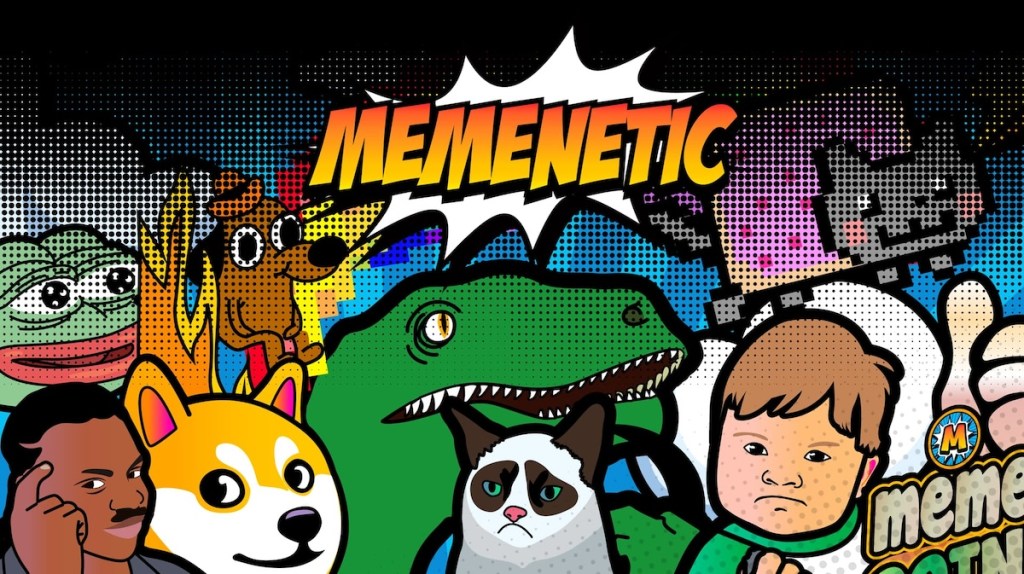
Memes have become a common form of humor in the digital realm, especially among younger generations. Now, memes are even shared to express certain feelings or actions in one’s life, making them a popular way to laugh with others online.
Memenetic allows users to create and share their memes with the world. This is especially popular among Gen Z, who use memes frequently to communicate with friends.
The humble beginnings of memes
Memes initially became popular during the internet’s popularity from the 1990s to the early 2000s, when users shared laughs in chat rooms or over email. One of the first widespread memes was a gif of a dancing baby, which even made its way onto television, demonstrating its worldwide popularity.
After that, bold, white font captioned images became popular. This format is still popular today, although it is often used ironically for younger generations. Websites like MySpace, Facebook, Twitter, TikTok, and Instagram can be accredited with popularizing meme-sharing amongst online users.
Memes’ evolution
Although memes were once used as jokes, they are now mainstream cultural references. Popular memes like the peanut butter baby and the “this is fine” cartoon dog are references that younger generations quickly recognize. Being exposed to these memes numerous times makes them easy to refer to in a digital age where everyone can access the same findings.
Memes ultimately reflect societal changes—what was once a humorous take on unserious topics has become a way to demonstrate political and social commentaries. Sharing memes goes beyond simple jokes and is now essential for younger audiences to speak their minds.
Memes in mainstream pop culture
As older forms of media adapt to modern interests, it’s evident that memes are prevalent in talk shows, TV shows, movies, and advertisements. Ads have become increasingly meme-centered, making light of their products and using humor to attract people’s attention.
“Brain rot” is a popular term that makes fun of the low-quality media people consume. Yet, large franchises are taking advantage of this opportunity, using “brain rot” to make fun of themselves for advertising purposes. Memes have become a central part of communication worldwide.
The rise of Memenetic
Understanding and creating memes to communicate with others is more important than ever. Memenetic allows people to create their own memes, allowing them to show off their creativity, humor, originality, and opinions.
Memes are so prevalent that Memenetic saw over 467,289 memes downloaded from their platform in the first week of their launch. There’s no doubt that people are interested in a place where they can be creative and share others’ creativity.
The future of memes is here
Worldwide, internet users will continue to see memes shape communication and entertainment. Memes will undoubtedly integrate with rising technology like virtual reality and AI-powered platforms, solidifying their place in culture.
Memenetic hopes to become a centralized platform for people to find relevant, funny memes and create inspiring content. As memes have grown, platforms are arising to meet the growing desire for meme-forward content. Memenetics can become a powerful tool to help shape future viral memes.
VentureBeat newsroom and editorial staff were not involved in the creation of this content.
Technology
In memory of Steve O’Hear

TechCrunch has lost one of its beloved former colleagues. Steve O’Hear, who wrote for TechCrunch for more than a decade out of his hometown of London, has passed away after a short illness. He was 49.
It’s hard to put into words the remarkable talent that Steve was. Born with muscular dystrophy, he spent his life in a wheelchair and had significant health, mobility and accessibility issues, but he was easily one of the most productive journalists any of us have ever worked with.
Steve brought his A-game to this organization every day he worked here and was a huge part of what made (and makes — you can read his 3,210 posts, a veritable magnum opus, here) TechCrunch great.
Steve was a dogged news hound who broke tons of stories. He also wrote grand features, spoke truth to power, and was, quite simply, an original and unmistakable voice.
Steve first joined TechCrunch in 2009, hired to help create a footprint for TechCrunch in Europe and conversely give the early tech ecosystem here exposure to the rest of the world.
Steve was fearless and more than a writer. Well before he came to TechCrunch, in 2004, fascinated with the gravity pull Silicon Valley was clearly exerting as far as Europe, he traveled to California with two friends in search of what made it tick and made a film about it. You can see that film here.

He was also a huge music lover who reveled in that world, too, building audio hardware and making music himself (as a keyboard player).
Like a lot of people who end up writing about startups, he also had a strong entrepreneurial streak. He left TechCrunch in late 2011 to co-found a semantic Q&A/search platform called Beepl. Alas, it didn’t toot enough horns. Eventually, Steve followed the great TechCrunch boomerang and came back here.
Steve was a natural at TechCrunch, deftly handling the two sides of what it means to work in a high-performing team.
He was fiercely independent, competitive and proud of his work, relentlessly pursuing stories, twisting arms, developing leads and spilling the beans — (usually!) with a smile, but taking no prisoners, and without suffering fools. He was also a consummate team player and friend, collaborating and helping others with their work. In our permanently distributed virtual office, Steve was a wonderful person to banter with on Slack about ridiculous things we’d seen.
As tech grew and TechCrunch grew, so did Steve’s profile. He was an excellent on-stage interviewer and he took on some iconic and some tricky, yet ultimately inspiring subjects over the years.
He eventually got the bug to do something different again and took a big veer back into startup land, working for quick commerce player Zapp.
The hard and fast rules of startup life turned him in a different direction eventually, and he once again started his own business, a communications consultancy called O’Hear & Co. As the firm said earlier, their plan is to continue with the vision Steve had.
It’s a huge loss, and he’s gone too soon. Our hearts, and our deepest sympathies, go out to his former colleagues, his friends, his wife Sara, and his family.
– Mike Butcher and Ingrid Lunden
(Some more words below from the team as they come in. As we like to say here, please refresh for updates.)
Connie Loizos, editor in chief of TechCrunch
I spent seven years working with Steve and while we were rarely in the same place at the same time, he seemed ubiquitous inside of TechCrunch, producing an impressive volume of work about up-and-coming founders in London and Berlin particularly, but also actively engaging in our own internal social channels to flag the news he was covering, share tips for others to chase down, and occasionally, good-humoredly, complain – as we all do in the news business – about our rivals.
He cared about TechCrunch, and TechCrunch cared about him. Among his parting words to all of us, in 2021, were these: “Thanks to everyone for making me feel valued and giving me the freedom to keep on learning and keep on scooping. If I had to give any advice to newcomers (not that you asked for it): TechCrunch is an amazing platform and like no other in this biz – use its special powers to do your best work and it will give you back double.”
Natasha Lomas
I only met Steve — professionally and in person — after I joined TechCrunch in 2012. But I soon realised I had already come across this guy on ‘the socials’, as he might have jokingly riffed back then. His strength of character and love of hustling meant he could play Twitter like a DJ dropping the big tunes at the club. Of course, he expected nothing less than the crowd to go wild. Mic drops were his bread and butter.
In person his character was no less large, no less magnetic than his social media self. While, professionally, I found — to my delight — I had acquired a colleague who was generous to a fault. Always happy to hear from you and genuinely interested to be a sounding board for story ideas. He also had a mentor’s keenness to help anyone who didn’t have his labyrinthine expertise of the ins & outs of VC funding — which was, in truth, most of the rest of his colleagues. Outside the fold I suspect he didn’t suffer fools gladly. But for a guy of his whip-smart intelligence you’d expect nothing less. Dear Steve, we already miss you so much.
The news of Steve’s death is a real shock. He rarely talked about his health. It was just like Steve to play that down – because he was busy turning the volume up on the rest of the world.
Devin Coldewey
I worked with Steve on and off for many years, and while we only got to talk in person a handful of times (as it is with many of my colleagues and friends here), I can credit him with igniting my interest in covering accessibility. Of course he covered countless other topics deeply, and I also learned about interview technique from watching him. But he was a well informed, and passionate advocate for accessibility and critic of the tech industry’s historically rather slack approach to this vital issue. He set me right plenty of times over the years and I was sad to lose his expertise when he left TechCrunch; even sadder now that I’ll never get his insight again.
Romain Dillet
Steve was also the epitome of a curious person. When you thought you had him figured out, with his witty personality, he would surprise you with an unexpected move. In the late 2010s, he completely immersed himself in a new passion — music.
After spending a small fortune on synthesizers, sequencers and other music equipment, he went so far as to record an album. You can still listen to Steve’s — or perhaps I should say Otis ‘Max’ Load’s — album on Spotify and Apple Music.
He described these ten songs as his “debut solo/concept album with friends.” This phrase alone perfectly encapsulates Steve’s personality. He didn’t just want to record an album; it had to be a concept album. And it wasn’t just a solo album, it was a solo album… with friends.
Loving music is one thing, but loving music so much that you want to make music with friends and release it to the world is another. Steve had an irresistible urge to share his love of music with others.
And yes, ‘In Between Floors’ was supposed to be his debut album…
Steve was a creative force with so much to share with the world. Many of his headlines and musical arrangements are still available on the internet. That’s the beauty of the web, a medium he cherished because it gave him the superpower to reach such a wide audience. It let him do what he loved. So let’s do the same.
Technology
The stunning indie game Gris now has a beautiful follow-up about love and loss

“I told him, no problem, as long as it’s not a four-legged animal, you can do whatever you want,” says lead producer Roger Mendoza, noting that animating critters with lots of legs can be “quite painful.” But the director was able to make the case for a game called Neva about a young woman who goes on an emotional journey with a magical fox creature. “I think it was worth it,” Mendoza admits.
Neva launches on October 15th (it’s coming to PC, Switch, Xbox, and PS5), and like Gris, it’s a stunningly animated 2D adventure. Players take on the role of a young woman caring for a young fox pup named Neva, trying to usher it to safety in a world filled with dark forces that look ripped out of Spirited Away. It only takes around five hours to finish, but the game spans a long period of time; each chapter is a different season, and you see the fox grow over time. At first, it’s a relatively helpless pup, but by the end, it becomes your protector.
Neva and Gris share a lot in common: the short length, approachable gameplay, incredible art and animation, and narrative that’s told almost entirely without words. (Neva does have some voice acting, but it’s multiple variations of the heroine calling out Neva’s name. “I think we recorded 500 different ways of saying Neva,” jokes Mendoza.) But the new game also introduces two major features: not only a second character but also combat.
“When she’s not with you, you really feel it.”
According to Mendoza, the latter was inspired by the former. “[The addition of Neva] was in a way where the combat came from — we thought it would be a good mechanic to bring together the fact that there’s a companion now,” he explains. Early on, you have to fight to protect the fox, but as she grows up and changes, so, too, does that dynamic. “Now she’s the one who is taking care of you,” Mendoza says. “When she’s not with you, you really feel it. Combat felt like a good way to tie everything together.”
This presented a number of design challenges, most notably in terms of accessibility. One of Gris’ biggest strengths was how easy it was to pick up and play; it even worked well on a smartphone touchscreen. But the added layer of complexity that comes from combat and a companion meant that Neva “isn’t as approachable as Gris,” according to Mendoza. “That’s something that we knew early on; the moment you add more controls, it becomes more difficult.” To account for this, the developers designed the game from the beginning with a story mode, where you can’t die in battle. “That was a way to try to find the right balance,” he says.
The success of Gris — the game sold more than 3 million copies to date — gave the studio the confidence to both push in these more ambitious directions but also continue to pursue its strengths. One of the major learnings from that game, according to Mendoza, was that “you can do a strong narrative without the need for words. It’s something that we had no idea if it would work on Gris.” Neva takes things a step further, with a more direct storyline that covers a number of topics simultaneously — not only the evolving nature of a parental relationship but also overt themes about environmental destruction. Again, this story is conveyed almost entirely through art, sound, and animation.
The other major learning from Gris was more practical. One of the main reasons that game’s development was so stressful and required such a long post-launch vacation was that the team was relatively small. In fact, only two programmers worked on Gris at all, forcing lots of late nights and long hours. Now that many members of Nomada are a little older, with families of their own, work-life balance is a much bigger priority. And so one of the most important changes between Gris and Neva was a seemingly simple one: “we hired more programmers.”
Technology
Quordle today – hints and answers for Tuesday, October 15 (game #995)
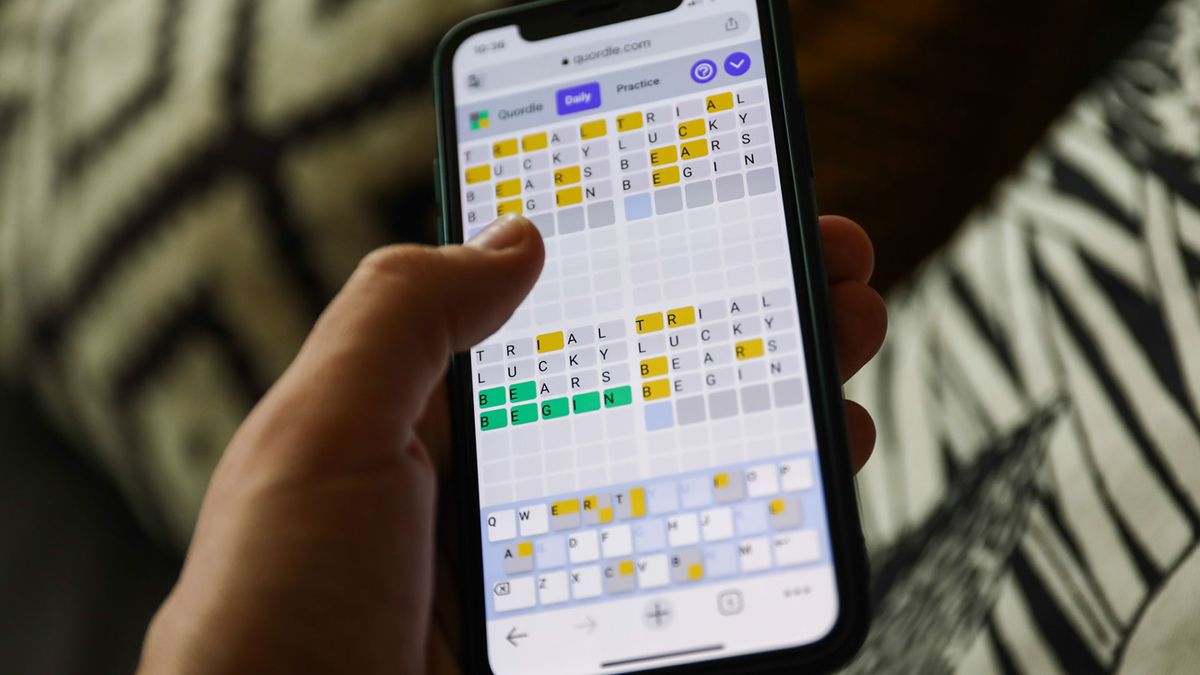
Quordle was one of the original Wordle alternatives and is still going strong now nearly 1,000 games later. It offers a genuine challenge, though, so read on if you need some Quordle hints today – or scroll down further for the answers.
Enjoy playing word games? You can also check out my Wordle today, NYT Connections today and NYT Strands today pages for hints and answers for those puzzles.
SPOILER WARNING: Information about Quordle today is below, so don’t read on if you don’t want to know the answers.

View today’s Quordle hints
Quordle today (game #995) – hint #1 – Vowels
How many different vowels are in Quordle today?
• The number of different vowels in Quordle today is 5*.
* Note that by vowel we mean the five standard vowels (A, E, I, O, U), not Y (which is sometimes counted as a vowel too).
Quordle today (game #995) – hint #2 – repeated letters
Do any of today’s Quordle answers contain repeated letters?
• The number of Quordle answers containing a repeated letter today is 0.
Quordle today (game #995) – hint #3 – uncommon letters
Do the letters Q, Z, X or J appear in Quordle today?
• No. None of Q, Z, X or J appear among today’s Quordle answers.
Quordle today (game #995) – hint #4 – starting letters (1)
Do any of today’s Quordle puzzles start with the same letter?
• The number of today’s Quordle answers starting with the same letter is 0.
If you just want to know the answers at this stage, simply scroll down. If you’re not ready yet then here’s one more clue to make things a lot easier:
Quordle today (game #995) – hint #5 – starting letters (2)
What letters do today’s Quordle answers start with?
• U
• B
• G
• T
Right, the answers are below, so DO NOT SCROLL ANY FURTHER IF YOU DON’T WANT TO SEE THEM.
Quordle today (game #995) – the answers
View today’s Quordle answers

The answers to today’s Quordle, game #995, are…
Phew! This was a tough one, with a couple of fairly obscure words in UMBRA and TORUS and a couple of others that have slightly common letters in places where they often wouldn’t be. GRAVY was probably the easiest, then BRIEF – although that F at the end doesn’t occur all that often. But it was the other two that will have caused most trouble.
My memory isn’t great, but I’m pretty sure we had UMBRA not that long ago in Quordle. It means “a conical shadow excluding all light from a given source” and is probably not a word most people use that often. TORUS is similarly obscure: “a doughnut-shaped surface generated by a circle rotated about an axis in its plane that does not intersect the circle”. I’m all for less common words being in Quordle – anyone who plays should love language, after all – but it sure made today’s game harder.
How did you do today? Send me an email and let me know.
View today’s Quordle Daily Sequence answers
Daily Sequence today (game #995) – the answers
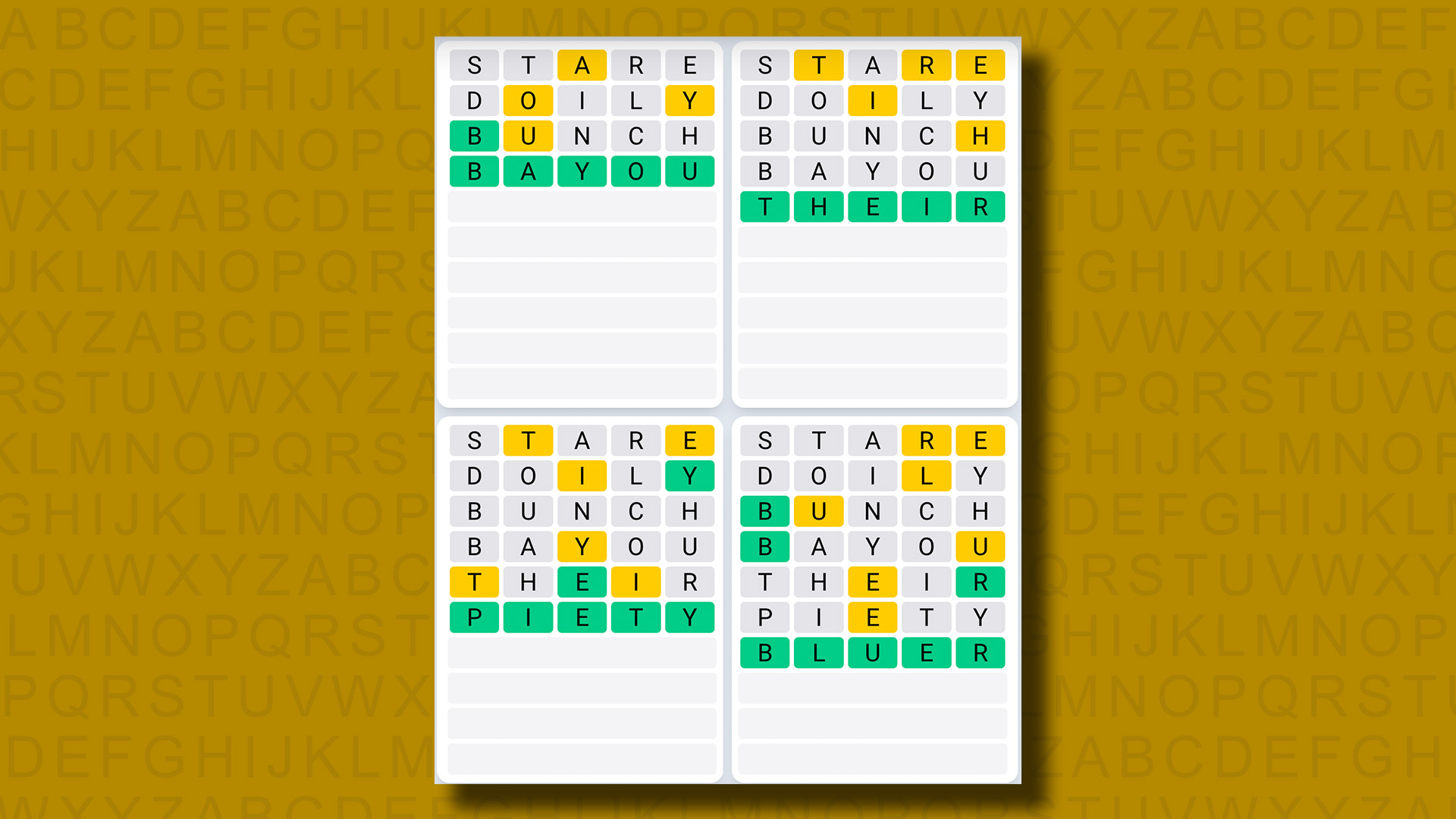
The answers to today’s Quordle Daily Sequence, game #995, are…
Quordle answers: The past 20
- Quordle #994, Monday 14 October: ROGUE, STORY, EMCEE, AUNTY
- Quordle #993, Sunday 13 October: UNFIT, NYMPH, THUMB, PUREE
- Quordle #992, Saturday 12 October: SAUCY, UNDUE, EGRET, HELLO
- Quordle #991, Friday 11 October: RINSE, ANIME, PUSHY, ZEBRA
- Quordle #990, Thursday 10 October: UNTIL, MARSH, METAL, WINDY
- Quordle #989, Wednesday 9 October: TRIAL, HUSKY, DOWNY, TRADE
- Quordle #988, Tuesday 8 October: TROUT, HATER, BARGE, DOZEN
- Quordle #987, Monday 7 October: CAULK, HALVE, APING, HEATH
- Quordle #986, Sunday 6 October: FUDGE, TENOR, BEGAT, ROUSE
- Quordle #985, Saturday 5 October: ELECT, CROAK, FRISK, JAUNT
- Quordle #984, Friday 4 October: ELFIN, GRAIL, PATIO, RECAP
- Quordle #983, Thursday 3 October: TENTH, REMIT, CURVE, TOAST
- Quordle #982, Wednesday 2 October: ARGUE, CRANE, TOKEN, PRINT
- Quordle #981, Tuesday 1 October: FRILL, MADLY, GRANT, NYLON
- Quordle #980, Monday 30 September: CRUSH, TARDY, TEACH, STUMP
- Quordle #979, Sunday 29 September: SERIF, BORNE, WRITE, SLEEK
- Quordle #978, Saturday 28 September: BUSHY, CIVIC, SNOUT, EQUIP
- Quordle #977, Friday 27 September: GUEST, CHASM, ROOST, BASAL
- Quordle #976, Thursday 26 September: STAGE, VOGUE, CLUMP, HEATH
- Quordle #975, Wednesday 25 September: UMBRA, DADDY, GLAZE, PRANK
Technology
SpaceX’s Starship landing shown in stunning close-up videos


SpaceX has shared footage (below) showing a spectacular close-up view of the Starship’s launch and landing on Sunday.
The mission involved the fifth test flight of the Starship, comprising the first-stage Super Heavy booster and upper-stage Starship spacecraft.
The first video shows the 120-meter-tall vehicle roaring skyward from SpaceX’s facility in Boca Chica, Texas, creating 17 million pounds of thrust at launch as it goes.
Tower view at liftoff of Starship's fifth flight test pic.twitter.com/BAtcod2EVD
— SpaceX (@SpaceX) October 14, 2024
The next clip shows the extraordinary moment when the 70-meter-tall Super Heavy was secured by the launch tower’s giant mechanical arms as it returned to Earth just a few minutes after deploying the Starship spacecraft to orbit.
The final phase of Super Heavy's landing burn used the three center Raptor engines to precisely steer into catch position pic.twitter.com/BxQbOmT4yk
— SpaceX (@SpaceX) October 14, 2024
And this rocket’s-eye view shows the vehicle coming to rest on one of the arms.
Onboard view showing a catch fitting on Super Heavy as it contacts a chopstick catch beam pic.twitter.com/r1TVQEdITc
— SpaceX (@SpaceX) October 14, 2024
It was the first time for the Elon Musk-led spaceflight company to attempt the catch, and many doubted whether SpaceX would pull it off. But in a moment of pure brilliance, everything came together as the booster gently descended before nestling between the waiting arms of the launch tower.
The achievement is a big step forward for SpaceX as it readies the rocket for NASA’s Artemis III mission, which will involve putting the first woman and first person of color on the moon. In the mission, the Super Heavy will deploy the Starship spacecraft, which will make its way to a lunar orbit. There, two astronauts will transfer from NASA’s Orion spacecraft to the Starship, which will then descend to the lunar surface. The mission is currently scheduled for 2026, though the date could slip.
Before then, SpaceX will continue to test the Starship, refining the technology that powers the gigantic vehicle in a bid to get it ready for Artemis III.
The Starship spacecraft could eventually carry up to 100 crew members on a single flight. Elon Musk wants to use the vehicle for the first crewed trip to Mars, which could take place in the 2030s.
Technology
OPPO Find X8 series’ Camera Button confirmed by executive
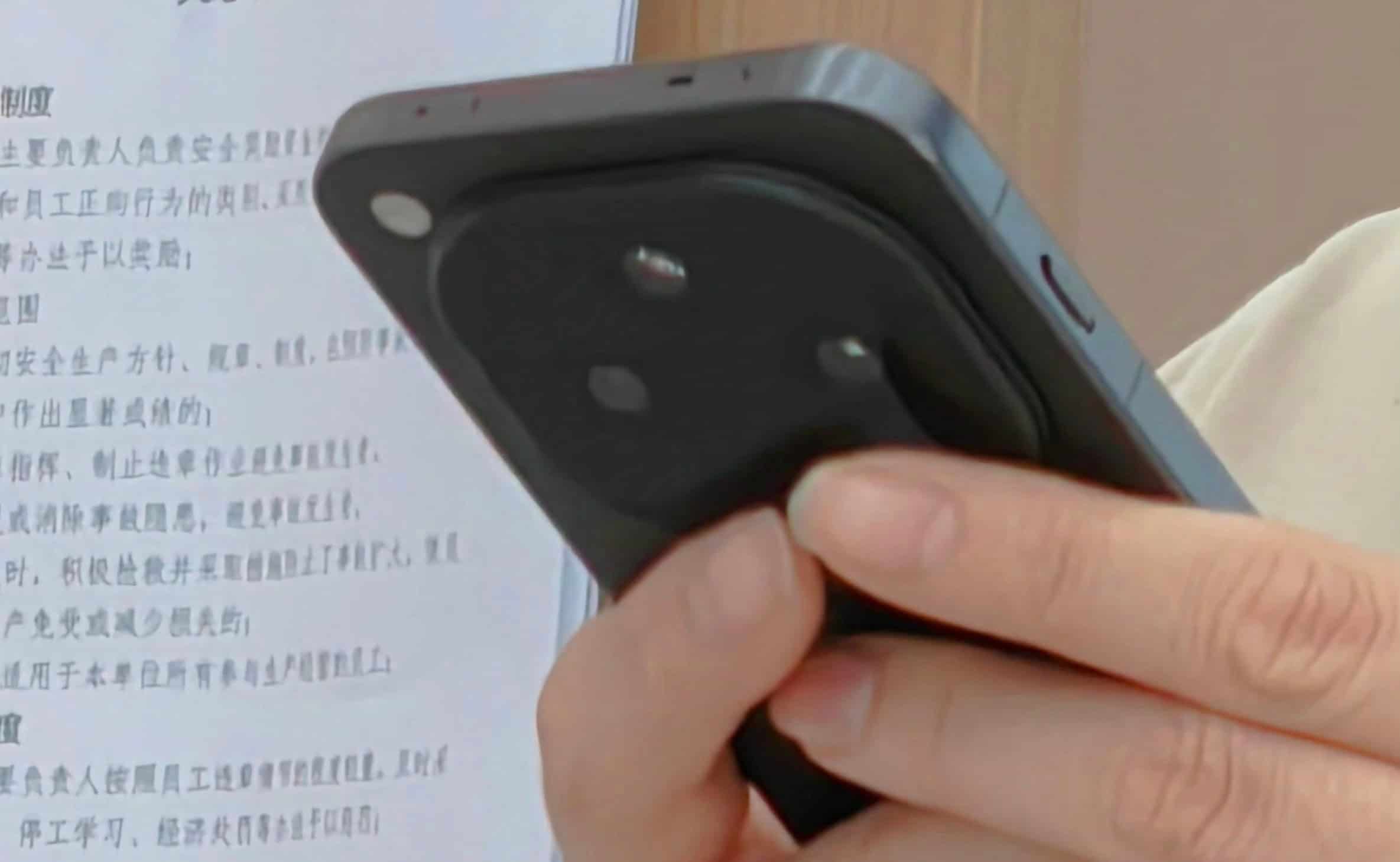
OPPO is one of the Android brands whose devices usually compete every year for the throne of “best camera phone.” The company has invested a lot of resources in boosting the photography section of its mobile devices. In line with this, and possibly inspired by the iPhone 16 series, the upcoming OPPO Find X8 series will feature a dedicated camera button.
Apple brought a dedicated physical button to offer a better camera experience on the iPhone 16 series. On Android, Sony stands out by including a dedicated shutter button on its flagship phones. However, Apple added more functionality by integrating a touch and pressure sensitive button. That means that the button can not only launch the camera app, set focus, and take photos, but also allows you to control the zoom by sliding on it.
A dedicated Camera Button will be present on the OPPO Find X8 series
Now OPPO has confirmed that its upcoming flagship phones will feature something similar. Zhou Yibao, product manager for OPPO Find products, confirmed the X8 series’ camera button with a short video on Weibo. The executive describes how the new button will work, and it’s actually pretty similar to what Apple offers, with a few minor differences.
On the iPhone 16 series, the Camera Control button lets you open the camera app with a single press. On the other hand, the camera button on the OPPO Find X8 series requires a double-tap to launch its equivalent. However, the rest of the functions, including zoom control via gestures on the button, seem the same. It’s noteworthy that the iPhone 16 series also lets you set the Camera Control to trigger the assigned action with a double-tap if you want.
A dedicated camera button can be quite useful and handy once you get used to it. Swiping to control zoom saves you from having to touch the screen or press the volume buttons, which is ideal if you need the best image stabilization possible. On the iPhone 16 series, users can also assign the button to launch other apps. The OPPO executive did not reveal whether the Find X8 series’ camera button will allow the same.
OPPO Find X8 series to arrive this month in China
The OPPO Find X8 series is expected to hit the Chinese market on October 24. Meanwhile, the global market should receive it sometime in 2025. Additionally, it will be the first time that the most premium “Ultra” model hits global markets. So, the competition for the best camera phone worldwide will be more intense than ever.
Technology
DJI’s Osmo Mobile 6 smartphone gimbal is cheaper than ever right now
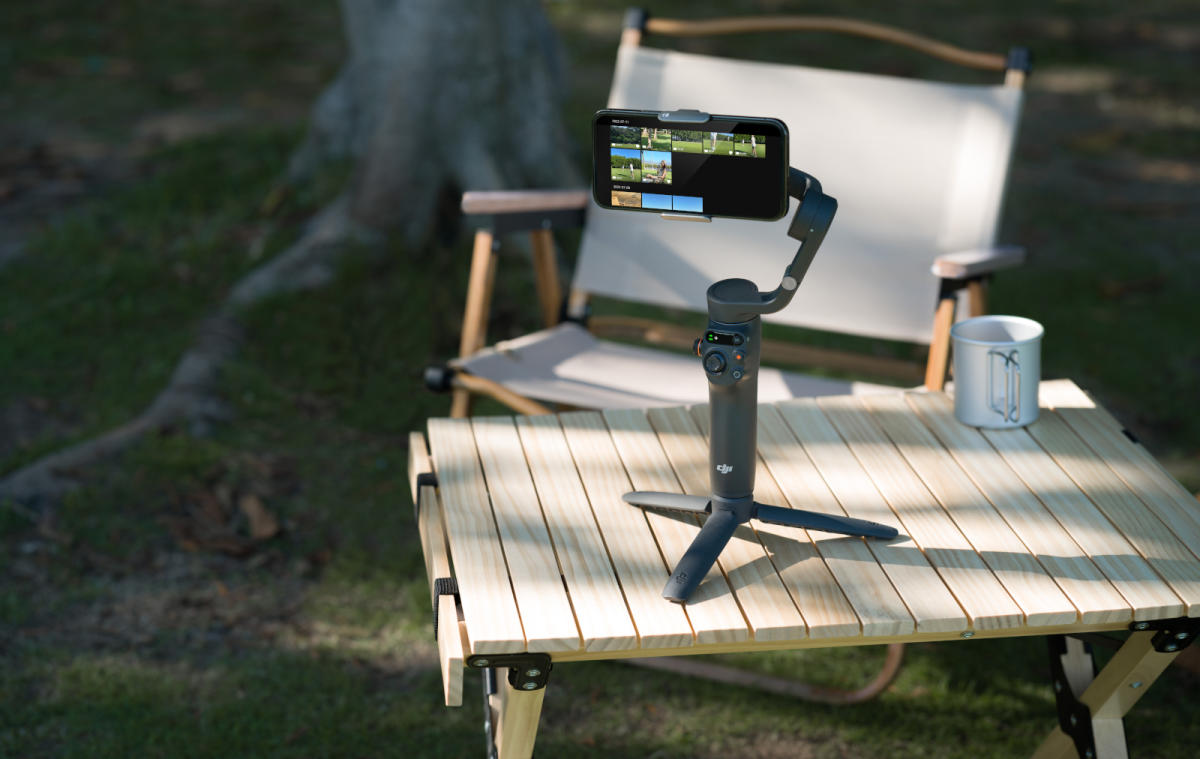
There are few faster ways to improve your smartphone photo and video game than by snapping up a gimbal. This increases image stabilization, reducing hand shake to make for smoother shots and help ensure a still is framed just as you want it. is an option worth considering, especially since it’s on sale. This model is currently $20 off, which brings it .
The Osmo Mobile 6 has a larger clamp than DJI’s previous models, meaning larger smartphones and ones with bulkier cases can slot in. If you attach an iPhone, the Mimo app goes into camera view when the gimbal is unfolded so you can start shooting photos and videos with it faster.
Vloggers, action videographers and still photographers alike could all benefit from the DJI Osmo Mobile 6. The smartphone gimbal has dropped to its lowest price ever in a new sale.
The handle is said to be more comfortable to hold compared with earlier versions. DJI retained the built-in extension rod from the previous model, so you can use the Osmo Mobile 6 as a selfie stick. You can set it up as a tripod too.
DJI included an array of smart features, such as timelapse, gesture control, automatic dynamic zoom, panorama and story mode. Using a side wheel, you can adjust the focal length and zoom level manually.
There’s a new status panel built in that displays battery levels and a button that lets you switch between various modes. DJI also upgraded its ActiveTrack feature. This supports stable tracking over longer distances and helps your phone’s front camera to better track subjects as they rotate.
Follow @EngadgetDeals on Twitter and subscribe to the Engadget Deals newsletter for the latest tech deals and buying advice.
-

 Science & Environment4 weeks ago
Science & Environment4 weeks agoHyperelastic gel is one of the stretchiest materials known to science
-

 Technology4 weeks ago
Technology4 weeks agoWould-be reality TV contestants ‘not looking real’
-

 Science & Environment4 weeks ago
Science & Environment4 weeks agoHow to unsnarl a tangle of threads, according to physics
-

 Science & Environment4 weeks ago
Science & Environment4 weeks ago‘Running of the bulls’ festival crowds move like charged particles
-

 Science & Environment4 weeks ago
Science & Environment4 weeks agoMaxwell’s demon charges quantum batteries inside of a quantum computer
-

 Science & Environment4 weeks ago
Science & Environment4 weeks agoLiquid crystals could improve quantum communication devices
-

 Womens Workouts3 weeks ago
Womens Workouts3 weeks ago3 Day Full Body Women’s Dumbbell Only Workout
-

 Science & Environment4 weeks ago
Science & Environment4 weeks agoQuantum ‘supersolid’ matter stirred using magnets
-

 Technology3 weeks ago
Technology3 weeks agoIs sharing your smartphone PIN part of a healthy relationship?
-

 Science & Environment3 weeks ago
Science & Environment3 weeks agoX-rays reveal half-billion-year-old insect ancestor
-

 Science & Environment4 weeks ago
Science & Environment4 weeks agoWhy this is a golden age for life to thrive across the universe
-

 Science & Environment4 weeks ago
Science & Environment4 weeks agoSunlight-trapping device can generate temperatures over 1000°C
-

 Science & Environment4 weeks ago
Science & Environment4 weeks agoNerve fibres in the brain could generate quantum entanglement
-

 Science & Environment4 weeks ago
Science & Environment4 weeks agoQuantum forces used to automatically assemble tiny device
-

 Science & Environment4 weeks ago
Science & Environment4 weeks agoHow to wrap your mind around the real multiverse
-

 Science & Environment4 weeks ago
Science & Environment4 weeks agoITER: Is the world’s biggest fusion experiment dead after new delay to 2035?
-
News4 weeks ago
the pick of new debut fiction
-

 Science & Environment4 weeks ago
Science & Environment4 weeks agoA slight curve helps rocks make the biggest splash
-

 News3 weeks ago
News3 weeks agoOur millionaire neighbour blocks us from using public footpath & screams at us in street.. it’s like living in a WARZONE – WordupNews
-

 Science & Environment4 weeks ago
Science & Environment4 weeks agoLaser helps turn an electron into a coil of mass and charge
-

 Science & Environment4 weeks ago
Science & Environment4 weeks agoPhysicists are grappling with their own reproducibility crisis
-

 Science & Environment4 weeks ago
Science & Environment4 weeks agoNuclear fusion experiment overcomes two key operating hurdles
-

 News4 weeks ago
News4 weeks ago▶️ Hamas in the West Bank: Rising Support and Deadly Attacks You Might Not Know About
-

 Science & Environment4 weeks ago
Science & Environment4 weeks agoTime travel sci-fi novel is a rip-roaringly good thought experiment
-
Business2 weeks ago
Eurosceptic Andrej Babiš eyes return to power in Czech Republic
-

 News4 weeks ago
News4 weeks agoYou’re a Hypocrite, And So Am I
-

 Sport4 weeks ago
Sport4 weeks agoJoshua vs Dubois: Chris Eubank Jr says ‘AJ’ could beat Tyson Fury and any other heavyweight in the world
-

 News4 weeks ago
News4 weeks ago▶️ Media Bias: How They Spin Attack on Hezbollah and Ignore the Reality
-

 Science & Environment4 weeks ago
Science & Environment4 weeks agoCaroline Ellison aims to duck prison sentence for role in FTX collapse
-

 News4 weeks ago
News4 weeks agoNew investigation ordered into ‘doorstep murder’ of Alistair Wilson
-

 Science & Environment4 weeks ago
Science & Environment4 weeks agoA new kind of experiment at the Large Hadron Collider could unravel quantum reality
-

 Technology2 weeks ago
Technology2 weeks agoQuantum computers may work better when they ignore causality
-
Business2 weeks ago
Should London’s tax exiles head for Spain, Italy . . . or Wales?
-

 Football2 weeks ago
Football2 weeks agoFootball Focus: Martin Keown on Liverpool’s Alisson Becker
-

 Sport2 weeks ago
Sport2 weeks agoWatch UFC star deliver ‘one of the most brutal knockouts ever’ that left opponent laid spark out on the canvas
-

 Science & Environment4 weeks ago
Science & Environment4 weeks agoRethinking space and time could let us do away with dark matter
-
News4 weeks ago
The Project Censored Newsletter – May 2024
-

 Technology3 weeks ago
Technology3 weeks agoWhy Machines Learn: A clever primer makes sense of what makes AI possible
-

 Technology2 weeks ago
Technology2 weeks ago‘From a toaster to a server’: UK startup promises 5x ‘speed up without changing a line of code’ as it plans to take on Nvidia, AMD in the generative AI battlefield
-

 MMA2 weeks ago
MMA2 weeks agoConor McGregor challenges ‘woeful’ Belal Muhammad, tells Ilia Topuria it’s ‘on sight’
-

 Technology2 weeks ago
Technology2 weeks agoMicrophone made of atom-thick graphene could be used in smartphones
-
Business2 weeks ago
Ukraine faces its darkest hour
-

 News4 weeks ago
News4 weeks agoIsrael strikes Lebanese targets as Hizbollah chief warns of ‘red lines’ crossed
-

 Health & fitness4 weeks ago
Health & fitness4 weeks agoThe secret to a six pack – and how to keep your washboard abs in 2022
-

 Technology4 weeks ago
Technology4 weeks agoThe ‘superfood’ taking over fields in northern India
-

 Science & Environment4 weeks ago
Science & Environment4 weeks agoA tale of two mysteries: ghostly neutrinos and the proton decay puzzle
-

 Science & Environment4 weeks ago
Science & Environment4 weeks agoFuture of fusion: How the UK’s JET reactor paved the way for ITER
-

 Technology3 weeks ago
Technology3 weeks agoGet ready for Meta Connect
-

 Science & Environment4 weeks ago
Science & Environment4 weeks agoUK spurns European invitation to join ITER nuclear fusion project
-
Politics4 weeks ago
UK consumer confidence falls sharply amid fears of ‘painful’ budget | Economics
-

 TV3 weeks ago
TV3 weeks agoCNN TÜRK – 🔴 Canlı Yayın ᴴᴰ – Canlı TV izle
-

 News3 weeks ago
News3 weeks agoWhy Is Everyone Excited About These Smart Insoles?
-

 Health & fitness2 weeks ago
Health & fitness2 weeks agoThe 7 lifestyle habits you can stop now for a slimmer face by next week
-

 Technology2 weeks ago
Technology2 weeks agoUniversity examiners fail to spot ChatGPT answers in real-world test
-
Politics3 weeks ago
Robert Jenrick vows to cut aid to countries that do not take back refused asylum seekers | Robert Jenrick
-

 Science & Environment4 weeks ago
Science & Environment4 weeks agoPhysicists have worked out how to melt any material
-

 Sport4 weeks ago
Sport4 weeks agoUFC Edmonton fight card revealed, including Brandon Moreno vs. Amir Albazi headliner
-

 News4 weeks ago
News4 weeks agoHow FedEx CEO Raj Subramaniam Is Adapting to a Post-Pandemic Economy
-

 Science & Environment4 weeks ago
Science & Environment4 weeks agoWhy we need to invoke philosophy to judge bizarre concepts in science
-

 CryptoCurrency4 weeks ago
CryptoCurrency4 weeks agoCardano founder to meet Argentina president Javier Milei
-

 MMA3 weeks ago
MMA3 weeks agoRankings Show: Is Umar Nurmagomedov a lock to become UFC champion?
-

 Science & Environment3 weeks ago
Science & Environment3 weeks agoMeet the world's first female male model | 7.30
-

 Womens Workouts3 weeks ago
Womens Workouts3 weeks ago3 Day Full Body Toning Workout for Women
-

 Technology3 weeks ago
Technology3 weeks agoRobo-tuna reveals how foldable fins help the speedy fish manoeuvre
-

 Servers computers3 weeks ago
Servers computers3 weeks agoWhat are the benefits of Blade servers compared to rack servers?
-

 Politics4 weeks ago
Politics4 weeks agoTrump says he will meet with Indian Prime Minister Narendra Modi next week
-

 Science & Environment4 weeks ago
Science & Environment4 weeks agoBeing in two places at once could make a quantum battery charge faster
-
Business4 weeks ago
Thames Water seeks extension on debt terms to avoid renationalisation
-
Politics4 weeks ago
‘Appalling’ rows over Sue Gray must stop, senior ministers say | Sue Gray
-

 Womens Workouts3 weeks ago
Womens Workouts3 weeks agoBest Exercises if You Want to Build a Great Physique
-

 Womens Workouts3 weeks ago
Womens Workouts3 weeks agoEverything a Beginner Needs to Know About Squatting
-

 News3 weeks ago
News3 weeks agoFour dead & 18 injured in horror mass shooting with victims ‘caught in crossfire’ as cops hunt multiple gunmen
-

 Technology2 weeks ago
Technology2 weeks agoThe best robot vacuum cleaners of 2024
-

 Entertainment1 week ago
Entertainment1 week agoChristopher Ciccone, artist and Madonna’s younger brother, dies at 63
-

 Business1 week ago
Business1 week agoWhen to tip and when not to tip
-

 News4 weeks ago
News4 weeks agoChurch same-sex split affecting bishop appointments
-

 CryptoCurrency4 weeks ago
CryptoCurrency4 weeks agoEthereum is a 'contrarian bet' into 2025, says Bitwise exec
-

 News4 weeks ago
News4 weeks agoBrian Tyree Henry on voicing young Megatron, his love for villain roles
-

 Health & fitness4 weeks ago
Health & fitness4 weeks agoThe maps that could hold the secret to curing cancer
-
Business4 weeks ago
JPMorgan in talks to take over Apple credit card from Goldman Sachs
-

 Science & Environment4 weeks ago
Science & Environment4 weeks agoTiny magnet could help measure gravity on the quantum scale
-

 CryptoCurrency4 weeks ago
CryptoCurrency4 weeks agoDecentraland X account hacked, phishing scam targets MANA airdrop
-

 CryptoCurrency4 weeks ago
CryptoCurrency4 weeks agoBitcoin miners steamrolled after electricity thefts, exchange ‘closure’ scam: Asia Express
-

 CryptoCurrency4 weeks ago
CryptoCurrency4 weeks agoDZ Bank partners with Boerse Stuttgart for crypto trading
-

 CryptoCurrency4 weeks ago
CryptoCurrency4 weeks agoLow users, sex predators kill Korean metaverses, 3AC sues Terra: Asia Express
-

 CryptoCurrency4 weeks ago
CryptoCurrency4 weeks agoBlockdaemon mulls 2026 IPO: Report
-

 News4 weeks ago
News4 weeks agoBrian Tyree Henry on voicing young Megatron, his love for villain roles
-

 Science & Environment3 weeks ago
Science & Environment3 weeks agoCNN TÜRK – 🔴 Canlı Yayın ᴴᴰ – Canlı TV izle
-

 News3 weeks ago
News3 weeks agoUS Newspapers Diluting Democratic Discourse with Political Bias
-

 Technology4 weeks ago
Technology4 weeks agoiPhone 15 Pro Max Camera Review: Depth and Reach
-

 Science & Environment4 weeks ago
Science & Environment4 weeks agoHow one theory ties together everything we know about the universe
-

 Science & Environment4 weeks ago
Science & Environment4 weeks agoQuantum time travel: The experiment to ‘send a particle into the past’
-

 Science & Environment4 weeks ago
Science & Environment4 weeks agoMost accurate clock ever can tick for 40 billion years without error
-

 CryptoCurrency4 weeks ago
CryptoCurrency4 weeks agoDorsey’s ‘marketplace of algorithms’ could fix social media… so why hasn’t it?
-

 CryptoCurrency4 weeks ago
CryptoCurrency4 weeks agoBitcoin bulls target $64K BTC price hurdle as US stocks eye new record
-
Business4 weeks ago
How Labour donor’s largesse tarnished government’s squeaky clean image
-

 CryptoCurrency4 weeks ago
CryptoCurrency4 weeks agoCoinbase’s cbBTC surges to third-largest wrapped BTC token in just one week
-

 Travel3 weeks ago
Travel3 weeks agoDelta signs codeshare agreement with SAS
-

 Politics3 weeks ago
Politics3 weeks agoHope, finally? Keir Starmer’s first conference in power – podcast | News
-
Business2 weeks ago
DoJ accuses Donald Trump of ‘private criminal effort’ to overturn 2020 election


You must be logged in to post a comment Login